Thermostat for heating: how to control the microclimate at
In climate networks with centralized coolant supply or autonomous heating systems equipped with outdated devices, it is impossible to regulate the microclimate in the home by changing the parameters of the boiler. Therefore, in order to set the desired temperature in the room with your own hands, it is necessary to use thermostats for heating mounted on radiators. It is about these mechanisms that will be discussed below.

Device description
Design features of the device
A thermostat on a heating radiator is a device mounted on the inlet of a battery of a water heating system, which allows you to adjust the intensity of heat transfer by reducing or increasing the amount of incoming coolant.
Note! Instructions for the installation of such a device provides for its use as a stop valve. So, if your radiator has leaked, a pre-installed thermostat in the heating system allows you to cut off the damaged area and perform the necessary repairs without stopping the work of the rest of the engineering network.
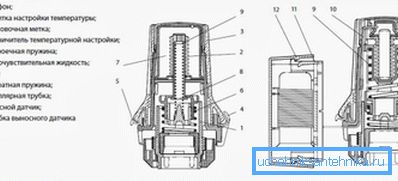
The temperature control valve has the following design features:
- Thermosensitive element. It is a flexible cylinder with walls in the form of an accordion, which is filled with a liquid that varies significantly in volume as a result of temperature exposure. As the temperature rises, the substance in the cylinder expands and increases the size of the cylinder, which, in turn, pushes the valve, which limits the volume of coolant flowing through the thermostat. In the event of a drop in ambient temperature, the thermostats for the heating system work in the reverse order. The substance in the temperature-sensitive element is designed for a huge number of expansion-compression cycles. Therefore, the valve will operate for at least one hundred years. There is no need to worry about replacing it.
- Connecting mechanism. It consists of two threaded couplings, with the help of which the thermostat for a heating radiator is joined to the heating pipes and the battery connection. The inlet and outlet can be located on the same axis or at an angle, which facilitates their installation.
- Housing It is made mainly of brass or other non-ferrous metal to avoid corrosion.
The main types of thermostatic elements are shown in the table:
| View | Description |
| RTD-G | It is used in heating systems having a one-pipe coolant supply scheme, where water flows over the batteries in series. They can also be part of a two-pipe circuit with a gravitational method of organizing the flow of a liquid (without using circulating pumps). |
| RTD-N | More often, such thermostats for radiators are used in climate networks of private cottages with a two-pipe wiring system and forced circulation of fluid through radiators. The price of these devices is slightly higher, but they more effectively regulate the temperature in the rooms. |
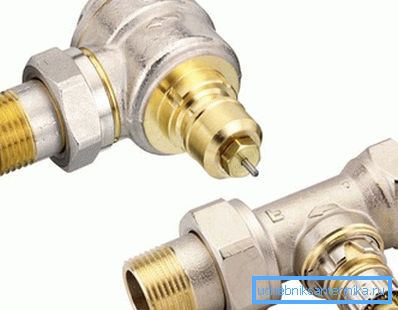
Note! When attaching a thermostatic valve to the inlet of the battery, care should be taken that its head is in a vertical position. Then, ascending warm flows from the radiator will not affect his work.
The principle of operation of the triple valve
There is another kind of regulatory equipment that has three nozzles:
- for supplying hot coolant;
- for supplying liquid from the return pipe (already cooled);
- to release mixed water at the right temperature.
Such a device works on the principle of a mixer in the bathroom. The heat carrier of different temperatures is fed through the inlet holes (as a rule, the difference is from 30 to 50 degrees), and at the outlet a heat flow with the necessary parameters is formed, which goes to the heating radiator.
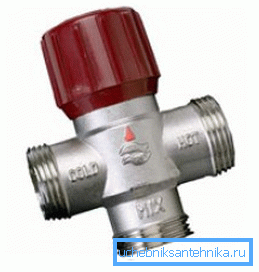
Note! The thermostats described above can be installed both on individual radiators and segments of the heating network, regulating the temperature of individual heating devices and the room as a whole.
When installing, pay attention to the labeling:
- The pipe connected to the heating pipe, which supplies the heat carrier, is marked in red.
- The hole through which the already cooled water will be supplied to the thermostat is indicated by blue.
- The output channel can be recognized by the black color marking.
Varieties of control equipment
Consider the main types of thermostats, which are represented in modern specialized stores of heating equipment.
- Mechanical. In this case, the desired temperature in the room is set with the help of a valve, on which various divisions are applied. Rotating the handle in one direction or another, you can increase or decrease the volume of incoming heat carrier and, thus, adjust the temperature in the room according to your desire.
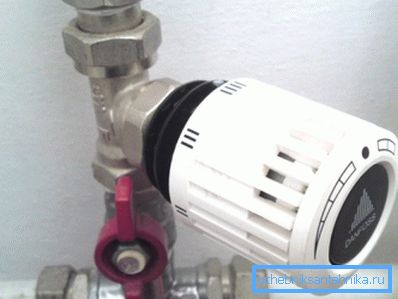
- Mechanical, with electronic valve adjustment. In such a device, the temperature is also set by the handle, but the valve moves due to a special electric device, which is turned on and off depending on the air temperature in the room.
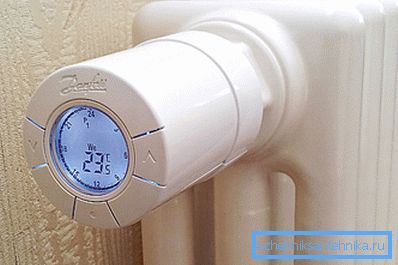
- Thermostat for radiators equipped with servo. This mechanism is an electric motor that pushes the valve thermostat heating. In this case, you set the desired temperature using the buttons on the device, and the servo drive itself increases or decreases the hole through which hot water enters the radiator.
This device more accurately regulates the temperature in the room in contrast to the mechanical varieties.

- Electronic thermostat. It is a special control panel with the help of which certain microclimate parameters are set. After that, a special controller gives commands to thermostats located in different parts of the house.
Using the electronic control panel you can achieve the most comfortable temperature in the house. In addition, the described thermostats can be part of the "smart home" system and be controlled by a specially tuned computer program.
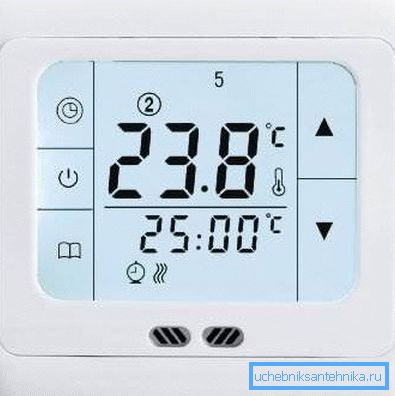
Installation of thermostat
Choosing an installation site
When choosing a thermostat mounting point, you should adhere to the following recommendations:
- The best place is the radiator inlet. However, it must be ensured that the valve head is not covered with decorative panels, curtains and other elements that prevent heat transfer. Failure to comply with this rule will lead to the fact that the thermostat will incorrectly read the temperature readings.
- If you do not meet the above requirement, you can install the device with a remote sensor.
- Another installation method is on a horizontal pipe that supplies water to the battery (not very far from the inlet).
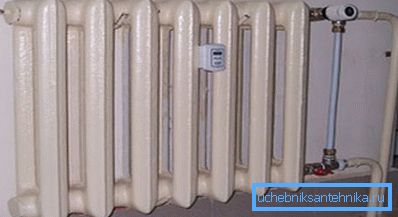
Installation Procedure
To install the thermostat on the battery, it is necessary to shut off the supply riser and drain the water there from pipes and radiators. After that, you can get to work.
The sequence of actions is as follows:
- It is necessary to cut the horizontal section of the pipeline supplying the coolant to the inlet of the battery.
- After that, disconnect the pipe from the battery and dismantle the shut-off valve (if it was).

- Next you need to install the shanks with nuts from the thermostatic valve on the inlet of the battery. To seal the joint, you can use tow or a special polymer tape.
- After that, the piping is assembled, part of which is the thermostat you purchased. When docking parts with each other, also pay attention to the correctness and accuracy of the assembly.
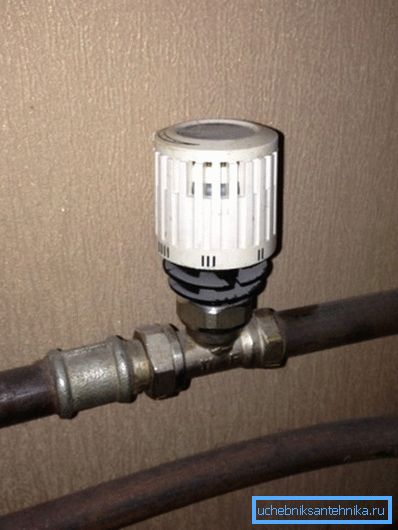
- The last stage is the connection of the strapping with the pipe supplying the coolant. Drives of the corresponding diameter are used.
Remember that when installing the valve in monotube systems it is necessary to provide for the installation of a bypass. This jumper connects the supply and exhaust pipes with each other. For the bypass, you need to take a part of a smaller diameter and embed it to the point where the valve is mounted.
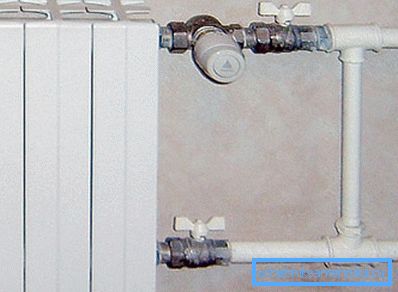
This should be done so that the installed thermostat does not block the access of the heat transfer medium to other batteries, greatly reducing the temperature in the other rooms (remote from the boiler).
This is especially important for apartments with vertical coolant flow. Incorrectly installed thermostat will block the flow of water to the dwellings located below, which will not add comfort and mood to your neighbors.
Conclusion
Thermostats for heating systems allow you to accurately set the temperature in the rooms. However, if you have an autonomous heating system installed in your house, it is better to regulate the microclimate using the electronic system of the boiler. So you not only reduce or increase the temperature, but also save the used energy carrier. For more on this, see the video in this article.